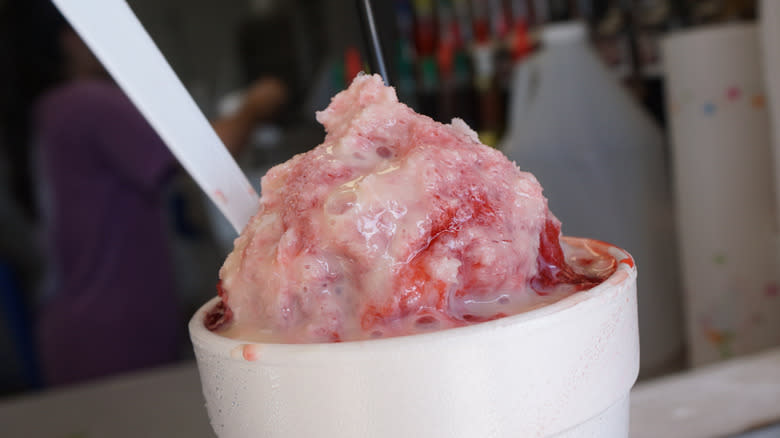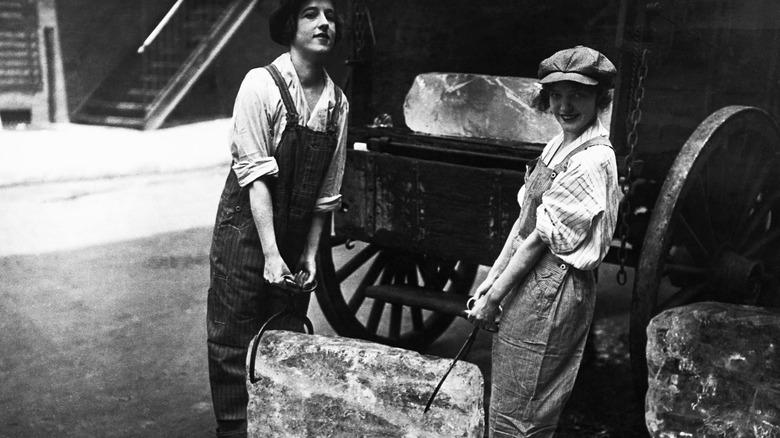The Fascinating History Of The New Orleans Sno-Ball

Ask anyone from New Orleans about the best way to experience New Orleans culture, and they'll probably say it's the food, and that could be anything from hitting the best places for beignets to ordering an authentic po'boy from a place that's been making them for a long time. If it's summertime, a foodie tour of New Orleans also involves some insane heat and a unique way to cool off: The sno-ball.
Sometimes it's written as snowball or snoball, but however it's spelled, we have to note that it's not the same as a snow cone. While snow cones are made from slivers or chunks of ice that allow the flavored syrup to run through (and probably pool at the bottom of the cone's container), the sno-ball lives up to the name. It's made from shaved ice that's light, fluffy, and exactly what you might expect from a snowball gathered from the first major winter snow. Sno-balls are smooth on the tongue: That consistency allows them to absorb the syrup better, making them sort of like a snow cone's overachieving sibling.
Sno-balls hit the New Orleans streets in the early 1900s; today, visitors can still stop by the original stand. On March 1, 2024, Hansen's Sno-Bliz celebrated its 85th season serving NOLA residents and visitors alike with a menu that included flavors like bubblegum, wedding cake, ginger cayenne, and honey lavender — most of which were probably never dreamed of decades before.
Read more: 21 Top Ice Cream Brands, Ranked By Flavor And Quality
Sno-Balls Were Sold At The Turn Of The Century

It's unclear who first stumbled on the idea of selling shaved and flavored ice on the streets of New Orleans, but we do know that street vendors peddling their frozen treats were mentioned in news articles as early as 1906. A 1938 reference from the "Works Progress Administration Guide to New Orleans" sets the scene (via 64 Parishes): "[A] snowball wagon [with] a block of ice, and on each side gaudy syrup bottles [served a] lump of shaved ice drenched in one of the colored syrups and served on a paper plate."
Although that makes it sound like there were a ton of choices, there weren't — strawberry, pineapple, and spearmint were the only three originally offered. Things started to change in a big way in the 1930s when two men both had the brilliant idea to automate the ice-shaving process.
One of those was Ernest Hansen. His wife, Mary, was the one who turned his ice-shaving machine into the heart of the business that would last well into the 21st century as New Orleans summertime hotspot Sno-Bliz. Meanwhile, George Ortolano was a grocery store owner and shaved ice seller who also invented a machine for shaving ice and new flavors. Today, those machines are still manufactured and sold. Interestingly, though, there's another contender for the originator of the sno-ball.
Baltimore Claims To Actually Be The Home Of The Famous New Orleans Treat

Baltimore, Maryland, and the Chesapeake Bay area also claim to be the original home of the sno-ball. Like the New Orleans version, these icy treats differ from snow cones in that they're made from lighter, fluffier ice that absorbs flavored syrups, so there's really no denying the fact that they have everything in common. One of the oldest sno-ball shops in Baltimore is the 1920s-era Walther Gardens and one of the most popular is the 1970s-era Snowball Stand.
Baltimore, it turns out, has been enjoying sno-balls since becoming a shipping hub — for goods that included blocks of ice — during the Industrial Revolution of the 1800s. The popularity of the treats skyrocketed during the Great Depression.
The whole Baltimore vs. New Orleans sno-ball debate seems to be a bit of a sore subject, and yes, history does remember the name of Baltimore's iconic sno-ball shop owner. "Meemaw" Sinsz owned and ran the original incarnation of the aforementioned Walther Gardens. While New Orleans was serving up its three staple flavors, it seems as though Sinsz was making and serving marshmallow and chocolate. Who's right? Anyone who says these are the perfect summertime treat, as far as we're concerned. (And wintertime treat — because, yes, fresh snow is the ultimate ingredient for frozen cocktails.)
Read the original article on The Daily Meal.


